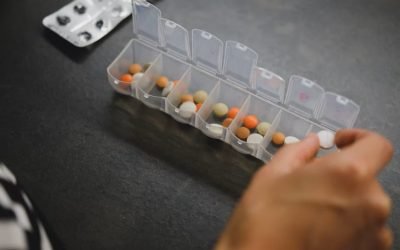Last updated: November, 2025
Substance addiction often begins long before the first signs are visible. It grows quietly in moments of pressure, fatigue or emotional tension, times when the body is overwhelmed and the mind searches for a way to cope. For some, substances offer a brief sense of steadiness; for others, they create distance from fear, sadness or uncertainty. What feels manageable at first gradually reshapes daily life, decisions and wellbeing.
Addiction develops when the nervous system becomes accustomed to this artificial balance. The person is not choosing chaos, they are managing discomfort with the tools available to them in that moment. Understanding this shift helps bring the conversation back to where it belongs: not in blame, but in clarity and care.
Substance addiction is treatable. With the right support, the nervous system can stabilise, emotions can soften, and life can regain rhythm and purpose. Recovery doesn’t happen through force; it begins with understanding how the body reached this point and how it can return to equilibrium again.
What Substance Addiction Really Means
Substance addiction changes the way the brain regulates motivation, reward, stress and emotional balance. It becomes more than repeated use; it becomes a pattern where the body relies on chemicals to function, and the mind turns to them for comfort or escape.
People who search what are the signs of substance addiction are often trying to make sense of emotional shifts: losing energy, withdrawing from others, or feeling unable to stop despite wanting to.
Substance Addiction vs. Non-Substance (Behavioural) Addiction
Behavioural addictions such as gambling or compulsive work share many emotional characteristics with substance addiction: loss of control, preoccupation, and difficulty stopping despite consequences.
But substance addiction directly changes the body’s chemistry. It creates tolerance, produces withdrawal, and can significantly impact physical health. Understanding this distinction helps individuals and families recognise when the body itself has become dependent, and when treatment for substance use disorder is necessary.
Why Substance Addiction Develops
Addiction rarely has a single cause. It is shaped by vulnerability, environment, emotional history and biological predispositions. Stress, trauma, loneliness, or prolonged pressure can push the nervous system to seek relief wherever it finds it.
Some people use substances to manage anxiety or insomnia; others reach for them to silence unresolved pain. Over time, this coping mechanism becomes a cycle that the body interprets as essential.
Genetics and Personal Vulnerability
Genetics influence how the brain reacts to substances, how quickly tolerance forms, and how the reward system adapts. Individuals with mental health conditions such as anxiety or depression may also be more vulnerable.
This interaction is why dual diagnosis treatment is often necessary: addiction and emotional health are deeply intertwined, and both need to be addressed together.
Signs and Symptoms to Pay Attention To
Symptoms of substance addiction can appear in different ways. Physically, there may be fatigue, disrupted sleep, loss of appetite, shaking or restlessness. Emotionally, people may feel anxious, numb, irritable or disconnected.
These aren’t signs of weakness: they are signals of a nervous system under strain.
Changes in Daily Functioning
One of the clearest indicators of addiction is a gradual change in routine. Sleep becomes unpredictable. Responsibilities feel overwhelming. Work or studies begin to suffer. People may withdraw from loved ones or hide their behaviour due to shame, guilt or confusion.
These shifts reflect the toll addiction takes on daily life, and they often lead individuals to search how to overcome substance addiction safely.
Withdrawal and Detox: What the Body Goes Through
When substance use stops, the body begins recalibrating. This period (withdrawal) can involve anxiety, irritability, insomnia, nausea or emotional instability. The intensity varies depending on the substance and frequency of use.
A medically supervised substance detox ensures safety during this stage, supporting the body as it adjusts and helping stabilise sleep, hydration, and mood.
Detox is not the end of recovery; it is simply a transition into clarity: the point where deeper therapeutic work can begin.
Treatment Options for Substance Addiction
Effective substance addiction treatment addresses the whole person: physical health, emotional resilience, psychological healing and daily stability.
People researching best substance addiction treatment centers in Spain often look for programmes that combine clinical precision with compassion, a calm environment where recovery is guided gently and respectfully.
Therapeutic Approaches That Support Real Change
Psychotherapy helps individuals understand the emotional roots of their addiction. Cognitive-behavioural therapy, trauma-informed care and relational therapy support new ways of navigating stress and internal conflict. This work builds awareness and gives the person tools to respond differently to emotional triggers.
Medication-Assisted Treatment and Medical Detox
Medication-assisted treatment can reduce cravings, stabilise mood and support the nervous system during early recovery.
When combined with medical detox, it provides a safer foundation from which to begin long-term healing.
This approach allows individuals to engage in therapy without the overwhelming intensity of unmanaged withdrawal.
Holistic and Somatic Therapies for Long-Term Balance
Holistic therapies complete the picture. Mindfulness, gentle movement, breathwork, art therapy, nutrition and time in nature help reconnect the person with their body’s rhythms.
These practices form the foundation of holistic addiction treatment, a method increasingly sought by individuals looking for integrative and sustainable recovery.
Life After Treatment: Rebuilding Balance and Purpose
Recovery becomes truly meaningful in the phase after treatment. Daily life returns, with its pressures, its unpredictability, its emotional demands… and the person must learn to move through it with new habits and a renewed sense of self.
This stage benefits from structure. Routine helps stabilise the nervous system; sleep patterns normalise; motivation gradually returns. Therapeutic support remains essential for navigating emotional triggers and maintaining clarity.
At Hacienda Paradiso, recovery continues through a dedicated 12-month aftercare program: a year of guidance, counselling and emotional support to help integrate change into everyday life. This continuity protects progress, reduces relapse risk and strengthens the foundations of long-term recovery.
Healing in Spain: A Supportive Environment for Recovery
Spain offers a gentle setting for recovery: a place where light, climate and landscape naturally encourage the body to slow down.
The quieter pace of life helps regulate the nervous system, making it easier to sleep, think clearly and reconnect with a sense of stability after periods of emotional or physical strain. For many, this environment becomes a steady companion in their healing — not dramatic, but quietly supportive, helping each step feel more grounded.
The Hacienda Paradiso Approach
At Hacienda Paradiso, this natural calm meets clinical expertise. Therapy unfolds in an environment designed for privacy, reflection and emotional safety. Treatment is personalised, discreet and paced gently, allowing the nervous system to find balance without pressure.
Here, recovery is approached with care rather than urgency: a process that honours the person’s physical needs, emotional history and capacity to heal. The aim is not simply to stop substance use, but to support a return to clarity, strength and a quieter sense of self.
Taking the First Step
Many people hesitate before seeking help, not because they don’t want to change, but because they feel tired, lost or afraid of being judged. Substance addiction thrives in silence, but recovery begins in connection.
Frequently Asked Questions: Substance Addiction
Substance addiction develops when the brain begins to rely on a substance to regulate stress, mood or energy.
What usually starts as occasional or coping use gradually becomes a pattern of dependence as the nervous system adapts. Over time, stopping becomes difficult not because of a lack of will, but because the body and mind have adjusted to this artificial balance.
Early signs often appear in small, gradual changes: disrupted sleep, shifts in mood, loss of interest in daily routines, secrecy, or difficulty managing stress without substances.
These symptoms are not moral failings, they are indications that the nervous system is under strain and may need support.
Changes in behaviour are often the first clues: social withdrawal, unpredictable emotions, declining performance at work or school, or avoiding conversations about their wellbeing.
Approach them gently, without accusation. Most people already carry shame; what they need is understanding and space to speak honestly.
Substance addiction is considered a chronic, treatable condition, not a choice.
It involves changes in brain chemistry, emotional regulation and stress responses. Recognising it as a health condition reduces stigma and opens the door to compassionate, effective treatment.
Overcoming addiction safely requires professional support. A medically supervised detox, therapy, and structured routines help stabilise the body and address the emotional patterns behind the addiction. Trying to stop alone can feel overwhelming; guided care creates safety and direction.
During detox, the body adjusts to the absence of the substance.
This may bring physical or emotional discomfort, but under medical supervision, symptoms can be managed safely. Detox is only the beginning, therapy, support and daily structure complete the recovery process.
Effective treatment combines several elements:
medical detox, psychological therapy, dual diagnosis care when mental health conditions are present, and holistic practices that restore balance.
This integrated approach supports both the biology of addiction and the emotional landscape beneath it.
Natural approaches (such as mindfulness, movement, nutrition and time in nature) can support recovery, especially when combined with evidence-based therapy.
These methods help regulate the nervous system and build stability, but they are most effective when part of a comprehensive treatment plan.
Recovery is different for everyone. Detox may take days, emotional stabilisation may take weeks, and rebuilding routine and confidence can take months. At Hacienda Paradiso, individuals receive 12 months of aftercare, helping them reinforce new patterns long after treatment ends.
Spain offers a calm, restorative environment that naturally supports recovery. The light, climate and slower rhythm of life help soften stress and stabilise the nervous system, an ideal setting for therapeutic work.
Centres like Hacienda Paradiso combine this environment with clinical expertise and deeply human care.








